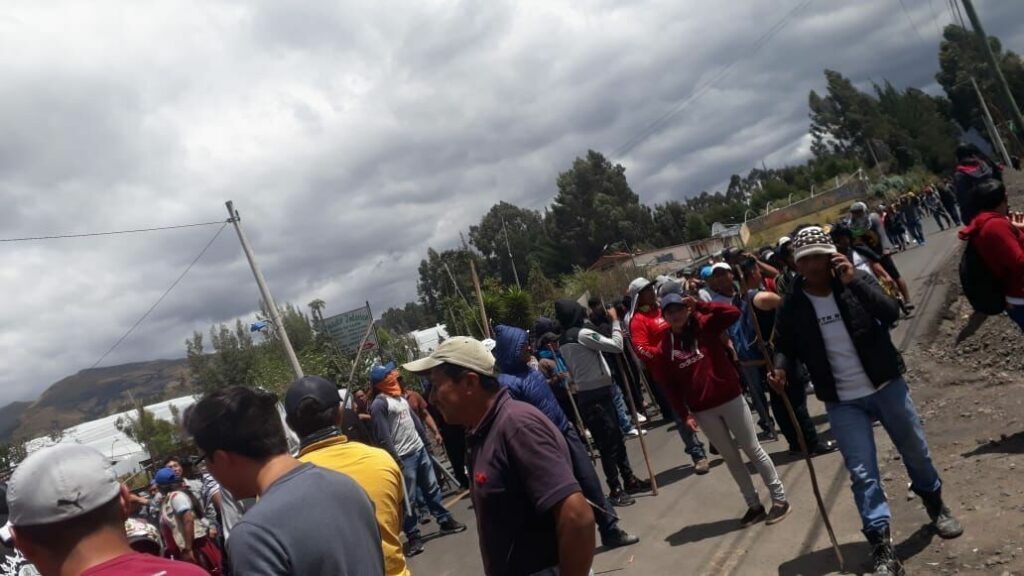The recent unrest in Ecuador came to an end when a deal was made on Monday 14 October. The protests against the economic measures have had a big impact on the Ecuadorean flower industry. Nurseries were visited by protesters, who paralysed and plundered the companies and forced workers to join the demonstrations. Transport was hindered by road blockades, extortion and violence.
The damage caused by the protests in Ecuador is significant. President Alejandro Martinez of exporters’ association Expoflores already estimated a loss of more than 30 million dollars after one week. Initially, the flower sector was mostly affected by the road blockades, which obstructed the transports to Quito airport. That was during the first couple of days of the unrest, from Thursday 3 October.

The actions that specifically targeted the flower companies started on Monday 6 October. Dozens of nurseries were visited by radical protesters, most of them masked and armed with sticks. They summoned employees to stop working and come along to Quito to demonstrate. Last Saturday, five companies were attacked. “Men were forced to get onto lorries and women were beaten by individuals in hoodies”, described Martinez. That same day, a lorry driver transporting flowers was attacked with a knife. Other actions included bribery at the road blockades, puncturing tyres and vandalising nurseries.
Expoflores is upset about how little protection the government offered to companies, employees and transport. They asked for help several times. They were promised military protection for flower transports for example, but in the end, very little was done to safeguard the transports.
Lost customers
Trader Jaap Constandse (Blossoms) has been living in Ecuador for decades, and he had never seen anything like this before. “The situation was very bad, and the consequences were significant. Growers couldn’t deliver to the airport or they couldn’t supply on time. One of my customers had a lorry in Amsterdam waiting for a consignment to Prague. That costs a thousand euros and the flowers never arrived. One day, I received orders from five different nurseries, and only one of them could supply. It’s true that protesters sometimes demanded money for a free passage, 50 dollars. And small nurseries were struggling more than the large flower farms. The big companies have computer-controlled watering systems. But at the smaller, two-to-four-hectare nurseries, where manual work is the norm, the crops got too dry and didn’t get any fertiliser for a week. If you lose a cycle, that’s 60 to 80 days gone. But if you have to throw everything away, it can take 200 days before you’re back to your old production volumes and quality.”
Ecuador could lose customers to other countries, realises Constandse. “Although Ecuador is known for its quality. So, in the long term, they might come back. But at the moment, I’m improvising and searching for new suppliers.”
Nightmare
A director of a large company in the Cotopaxi region, who wanted to stay anonymous, kept it short. “It’s terrible, a nightmare. We weren’t attacked by protesters but had to close down out of precaution. The targeted actions came as a complete surprise to us.”
Renowned Royal Flowers is based in the same region (Tabacundo in the province of Pichincha), northeast of the capital. Vice president Lenin Arias: “The situation was the worst in Cotopaxi. At our branch in Continex, we couldn’t supply 80 percent of our normal production. In Tabacundo, it was 50 percent. The protesters in Continex were very aggressive, some of our workers were beaten. In Tabacundo, we evacuated employees after we’d received certain threats. The unrest cost us around 75,000 dollars per day.”
Arias recognises that poverty is a major problem in his country. “The differences are big here. But the protests are far too violent. We must find a way to reduce poverty.”
After the deal was made, Royal Flowers was hoping their operations would be back to normal by Tuesday.
Juan Carlos of El Aleli is also based in a region where radicals were active, south of the capital. “We’re in a transitional phase, because we’re expanding from 2 to 10 hectares. But everything basically came to a halt. One employee stayed at the premises to water the crops. We had no access to transport. That’s a situation that can last for a week, but no longer than that.”
War zone
Considering the nature of the actions, the unrest looked more like terrorism and guerrilla than a ‘normal protest’. The Comptroller General’s office (where documents regarding corruption by the previous regime are kept) was set on fire, journalists and police officers were taken hostage, and last Saturday, there were so many fires and riots in Quito that it looked like a war zone. At 3 p.m., the government put the city on military lockdown. Air traffic was also disrupted.
Apart from ordinary resistance against the economic measures, it seemed that supporters of ex-president Correa were behind the chaos and the violence. The trading of illegal fuel also played a role. People are earning millions with it, because of the price difference with Colombia. Cocaine growers use cheap fuel from Ecuador for their production. And finally, there’s the interference from abroad. For instance, some Venezuelans were arrested when they were found in possession of information regarding the travel behaviour of the president and the vice president.
Ecuador is the third largest flower exporter in the world (10%) after the Netherlands and Colombia. The export value was 881 million dollars in 2017, three quarters of which were roses. The most important market is the USA (45%). A fifth goes to the European Union. The total acreage of flowers amounts to around 5,000 hectares. The sector employs more than 100,000 people.









